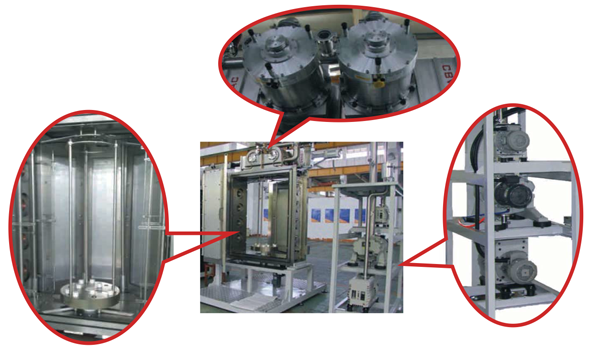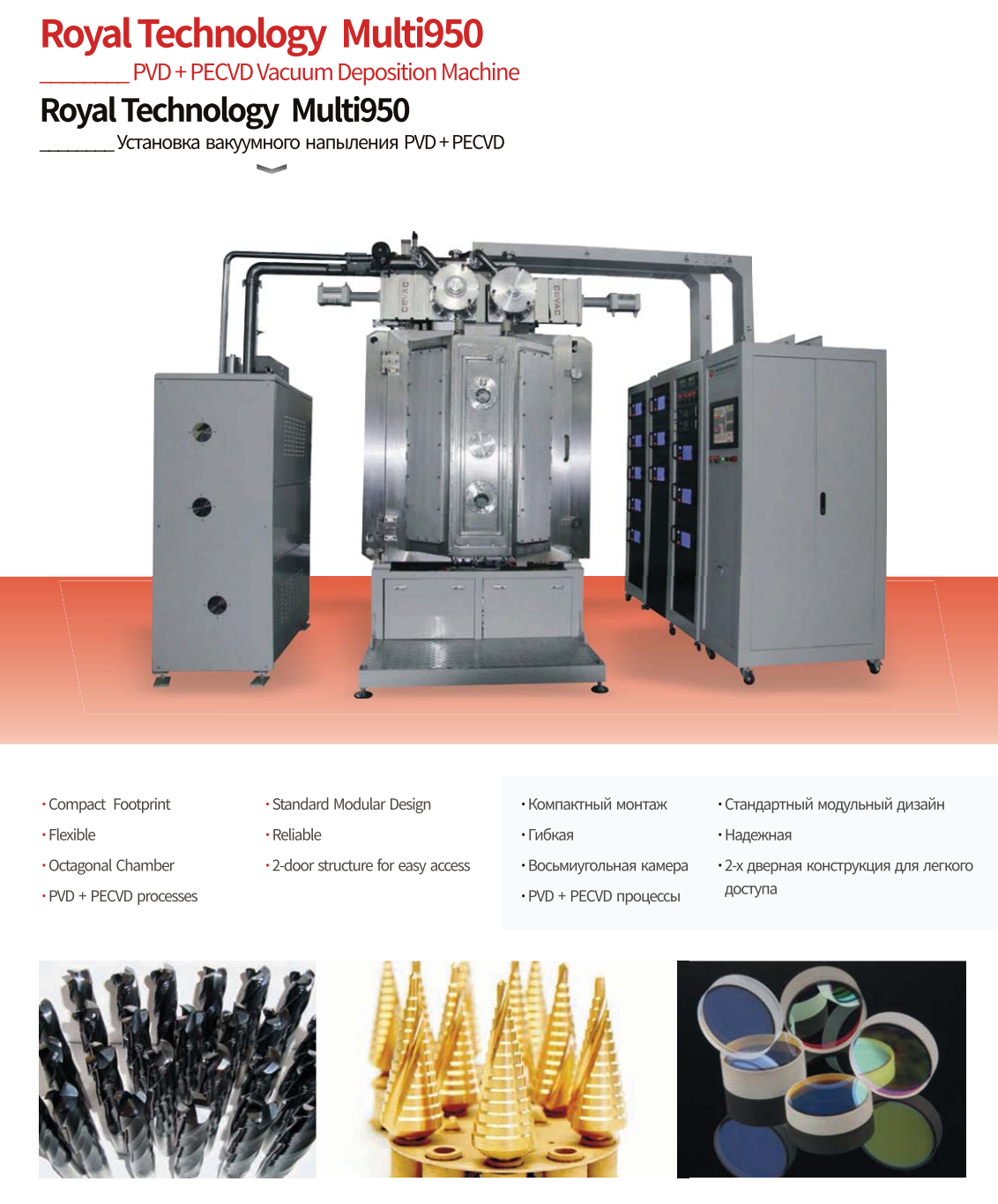Royal Technology Multi950 ——PVD + PECVD Vacuum Deposition Machine The Multi950 machine is a customized multiple function vacuum deposition system for R&D.
The Multi950 is the milestone of advanced design coating systems for Royal Technology. Thanks to students of Shanghai University and Professor Yigang Chen leading them with his creative and unselfish dedication, we were able to convert his valuable information into a state of the art machine.
In the year 2018, we had another project cooperation with Professor Chen, the C-60 material deposition by Inductive thermal evaporation method. Mr. Yimou Yang and Professor Chen were fundamental for these innovative projects.
After intense exchanges with Shanghai University’s team lead by Professor Chen, we finally confirmed the design and configuration to fulfill their R&D applications. This system is able to deposit transparent DLC film with the PECVD process, hard coatings on tools, and optical film with sputtering cathode. Based on this pilot machine design concept, we have developed 3 other coating systems afterwards:
1. Bipolar Plate Coating for Fuel Cell Electric Vehicles- FCEV1200
2. Ceramic Direct Plated Copper- DPC1200
3. Flexible Sputtering System- Copper PCB Gold Plating System- PCB1200
These 3 machines all have an Octagonal chamber, which allows flexible and reliable performance in various applications. It enables the coating processes and requires many different metal layers: Al, Cr, Cu, Au, Ag, Ni, Sn, SS and many other non-ferromagnetic metals. Plus the Ion source unit, efficiently enhances films adhesion on different substrate materials with its plasma etching performance and, the PECVD process to deposit some carbon-based layers.
Application: hard coatings, DLC , Sputtering Optical film.
Anode Layer Ion Source + Planar Sputtering Cathode + Arc cathode
The combination of PVD (Physical Vapor Deposition) and PECVD (Plasma-Enhanced Chemical Vapor Deposition) technologies in a hybrid coating machine allows for a wide range of applications across various industries. Some common applications of PVD and PECVD hybrid coatings include:
Wear and Corrosion Protection: Hybrid coatings are often used to improve the wear resistance and corrosion protection of components in industries such as automotive, aerospace, and manufacturing.
Optical Coatings: The hybrid machine can produce high-quality optical coatings for applications in lenses, mirrors, and other optical components, offering enhanced reflectivity, anti-reflection properties, and durability.
Decorative Coatings: PVD and PECVD hybrid coatings are utilized in the production of decorative finishes on consumer products, architectural elements, and jewelry, providing aesthetic appeal along with functional benefits.
Tool Coatings: Hybrid coatings are applied to cutting tools, molds, and dies to enhance their hardness, lubricity, and wear resistance, improving tool life and performance.
Biomedical Applications: PVD and PECVD hybrid coatings find use in biomedical applications for producing biocompatible coatings on medical implants, surgical instruments, and devices to improve biocompatibility and reduce wear.
Electronic Components: Hybrid coatings are used in the electronics industry for enhancing the performance and reliability of electronic components, such as providing barrier coatings, insulating layers, and conductor materials.
Energy Storage and Conversion: PVD and PECVD hybrid coatings are employed in energy storage and conversion devices, such as batteries, fuel cells, and solar cells, to improve efficiency, durability, and performance.
Packaging and Barrier Films: The hybrid machine is utilized to produce barrier coatings for packaging materials to extend the shelf life of food products, prevent moisture ingress, and enhance overall product protection.
MEMS and Nanotechnology: PVD and PECVD hybrid coatings play a crucial role in microelectromechanical systems (MEMS) and nanotechnology applications by providing functional coatings for sensors, actuators, and other micro-devices.
Automotive and Aerospace: Hybrid coatings are used in automotive and aerospace industries for applications such as improving fuel efficiency, reducing friction, enhancing aerodynamics, and protecting components from extreme operating conditions.
These are just a few examples of the diverse range of applications where PVD and PECVD hybrid coatings can be effectively utilized to enhance the performance, durability, and functionality of various products across different industries.
PVD (Physical Vapor Deposition) and PECVD (Plasma-Enhanced Chemical Vapor Deposition) hybrid coating machines combine the advantages of both technologies to offer enhanced coating capabilities. Some of the advantages of using a PVD and PECVD hybrid coating machine include:
Improved Coating Quality: The combination of PVD and PECVD processes can result in coatings with improved quality, such as enhanced adhesion, hardness, wear resistance, and corrosion resistance.
Versatility: The hybrid machine allows for a wider range of materials to be deposited, enabling the coating of substrates with various properties and compositions.
Enhanced Control: By utilizing both PVD and PECVD processes, operators can have better control over the coating parameters, resulting in precise deposition and tailor-made coatings.
Increased Efficiency: Combining these two technologies can lead to higher deposition rates and improved efficiency in the coating process compared to using each technology separately.
Cost Savings: Hybrid coating machines can offer cost savings by reducing the number of machines required for different types of coatings and by optimizing the coating process.
Customization: The hybrid machine allows for the customization of coatings by adjusting the parameters of both PVD and PECVD processes to meet specific requirements.
Multi-functional Coatings: The combination of PVD and PECVD processes enables the production of multi-functional coatings that possess a combination of properties such as hardness, lubricity, and chemical resistance in a single coating layer.
Reduced Environmental Impact: Hybrid coating machines can offer environmentally friendly coating solutions by optimizing the use of resources and reducing waste in the coating process.
In summary, the integration of PVD and PECVD technologies in a hybrid coating machine provides a range of advantages that can lead to improved coating quality, versatility, control, efficiency, cost savings, customization, and environmental sustainability.
Multi950-Design Features
1. Flexibility: Arc and sputtering cathodes, Ion source mounting flanges are standardized for flexible exchange
2. Versatility: It can deposit a variety of base metals and alloys; optical coatings, hard coatings, soft coatings, compound films and solid lubricating films on the metallic and non-metallic materials substrates
3. Straight forward design: 2-door structure, front & rear opening for easy maintenance
- Compact Footprint
- Standard Modular Design
- Flexible
- Reliable
- Octagonal Chamber Structure
- 2-door Structure For Easy Access
- PVD + PECVD processes

Model: Multi-950
Deposition chamber (mm)
Diameter x Height: φ950 x 1350
Deposition Sources : 1 pair of MF sputtering cathodes
1 pair of PECVD
8 sets arc cathodes
1 set Linear Ion Source
Plasma Uniformity Zone (mm): φ650 x H750
Carousel: 6 xφ300
Powers (KW) Bias: 1 x 36
MF Sputtering Power (KW): 1 x 36
PECVD (KW): 1 x36
Arc (KW): 8 x 5
Ion Source (KW): 1 x 5
Gas Control System MFC: 4 + 1
Heating System: 18KW, up to 500℃, with thermal couple PID control
High Vacuum Gate Valve: 2
Turbo molecular pump: 2 x 2000L/S
Roots Pump: 1 x 300L/S
Rotary Vanes Pump: 1 x 90 m3/h + 1 x 48 m3/h
Footprint (L x W x H ) mm: 3000 * 4000 * 3200
Total Power (KW): 150

Machine Model: Multi950
Built Time: 2015
Location: Shanghai University

E-catalogue for online review and download.

